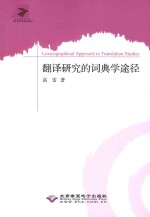

翻译研究的词典学途径PDF格式文档图书下载
- 购买点数:9 点
- 作 者:高雷著
- 出 版 社:北京希望电子出版社
- 出版年份:2016
- ISBN:9787830022792
- 标注页数:192 页
- PDF页数:204 页
Chapter 1 Introduction 1
1.1 Literature Review 1
1.2 Research Object 10
1.3 Research Objective 12
1.4 Research Methodology 13
1.4.1 Ontological Method 13
1.4.2 Lexicographical Method 14
1.5 Significance of the Research 14
1.5.1 Translation Studies 14
1.5.2 Compilation ofTranslatological Dictionaries 16
1.5.3 Lexicographical Study ofTranslation 16
1.6 Structure ofthe Research 17
1.7 Originality ofthe Research 18
1.7.1 Probe into the Sources ofTranslatological Dictionaries 18
1.7.2 Probe into the Functions of Translatological Dictionaries 19
Chapter 2 Lexicographical Source of Translatological Dictionaries 20
2.1 Development of Lexicography 20
2.2 Characteristics of Lexicography 29
2.2.1 Multidiscipline Integration 29
2.2.2 Open Perspective 31
2.2.3 Pragmatic Tendency 35
2.3 Summary 38
Chapter 3 Translatological Source of Translatological Dictionaries 40
3.1 Multivariate Paradigms of Translation Studies 40
3.1.1 Paradigm ofCreativity 41
3.1.2 Paradigm of Equivalence 46
3.1.3 Post-structuralist Translation Theories 50
3.2 Systematicness of Translation Studies 55
3.3 Openness of Translation Studies 60
3.4 Summary 62
Chapter 4 Constituents of Translatological Dictionaries 64
4.1 Name and Nature of Translatological Dictionaries 64
4.2 Materials of Translatological Dictionaries 67
4.2.1 Translatological Concepts 68
4.2.2 Translatological Terms 70
4.2.3 Translatological Proper Nouns 77
4.3 Forms of Translatological Dictionaries 80
4.3.1 Macrostructure 81
4.3.2 Microstructure 83
4.3.3 Physical Features 90
4.4 Production of Translatological Dictionaries 91
4.4.1 Noumenon 92
4.4.2 Phenomenon 95
4.4.3 Unification Between Noumenon and Phenomenon 97
4.5 Purpose of Translatological Dictionaries 98
4.6 Summary 101
Chapter 5 Theories of Translatological Dictionaries 102
5.1 Compilers 102
5.1.1 Perception 103
5.1.2 Understanding 104
5.1.3 Rationality 106
5.1.4 Professionalism 108
5.2 Inner System ofTranslatological Dictionaries 110
5.2.1 Nature ofTranslatological Dictionaries 110
5.2.2 Typology of Translatological Dictionaries 112
5.2.3 Compilation Principles of Translatological Dictionaries 116
5.2.4 Structure of Translatological Dictionaries 121
5.2.5 Criticism of Translatological Dictionaries 123
5.2.6 Functions of Translatological Dictionaries 125
5.2.7 History of Translatological Dictionaries 128
5.3 Users 128
5.3.1 Users'Consciousness 129
5.3.2 Users'Cognitive Competence 131
5.3.3 Users'Communication 134
5.4 Social Background 137
5.4.1 Publication of Translatological Dictionaries 137
5.4.2 Science and Technology 139
5.4.3 Ideology 142
5.5 Summary 144
Chapter 6 Discipline Functions of STD 146
6.1 Study of Translatological Dictionaries as a Sub-discipline 146
6.t.1 Inner Impetus 147
6.1.2 Discipline Environment 148
6.1.3 Discipline Index System 151
6.2 Lexicographical Approach to Translation Studies 160
6.3 Summary 165
Chapter 7 Conclusion 167
7.1 Main Findings 167
7.1.1 STD as an Interdisciplinary Research 167
7.1.2 Contributions 171
7.1.3 Ideas of Discipline Ecology 176
7.2 Limitations of the Research 177
7.2.1 Limitation in Empirical Study 177
7.2.2 Limitation in Case Study 178
7.2.3 Limitation in Research Literature 178
7.3 Future Study 179
7.3.1 Compilation of More Translatological Dictionaries 179
7.3.2 Attaching Importance to Translatological Dictionaries and Their Study 180
7.3.3 Making Out Criticism Specification of the Translatological Dictionary 182
Bibliography 187
- 《Lexicographical Approach to Translation Studies=翻译研究的词典学途径》高雷著 2016
- 《翻译研究的词典学途径》高雷著 2016
- 《翻译研究词典》(美)Mark Shuttleworth,(美)Moira Cowie著;谭载喜主译 2005
- 《双语词典的翻译研究》万江波著 2006
- 《翻译研究的功能途径》张美芳著 2005
- 《翻译学词典》马克(Mark,S.),莫伊拉(Moira,C.)著 2004
- 《2009译学词典语翻译研究文萃》孙迎春主编 2011
- 《翻译学词典编纂之研究》曾东京著;邵庆华,商晓芳,曾东京译 2009
- 《翻译学词典编纂之理论研究》曾东京著 2007
- 《汉译英翻译研究功能途径》司显柱,庞玉厚,程瑾涛著 2017
- 《翻译价值论》高雷著 2016
- 《风中往事》高雷著 2009
- 《高雷建筑画集》高雷著 2018
- 《Lexicographical Approach to Translation Studies=翻译研究的词典学途径》高雷著 2016
- 《水稻种植户生产行为研究 基于要素投入视角》高雷著 2017
- 《翻译研究的词典学途径》高雷著 2016
- 《建筑配景画图集》高雷编绘 1995
- 《学生建筑速写集》高雷编 1996
- 《江婴诗集》江婴著;高雷编 2000
- 《建筑配景集锦》高雷编 1990
- 《操作系统COOL Linux+Windows 2000》范醒哲,潘桦主编北京希望电脑公司总策划 1999
- 《'94北京国际电子出版研讨会论文集》粟武宾主编 1994
- 《北京市电子商务发展报告 2005》北京市信息化工作办公室,北京市统计局组织编写 2006
- 《网络互联技术手册 第2版》(美)(K.唐斯)Kevin Downes等著;包晓露等译 1999
- 《电子电路学习指导与解题指南 修订版》解月珍,谢沅清编著 2006
- 《电子电路实验》梅开乡,梅军进主编;陈大力,吴勇平,李鹏鹏副主编 2014
- 《THE GOVERNMENT/PRESS CONNECTION PRESS OFFICERS AND THEIR OFFICES》STEPHEN HESS 1984
- 《电子控制基本电路实验》孙心若主编 2007
- 《谈骨论筋 上》赵勇编著 2014
- 《谈骨论筋 下》赵勇编著 2014
